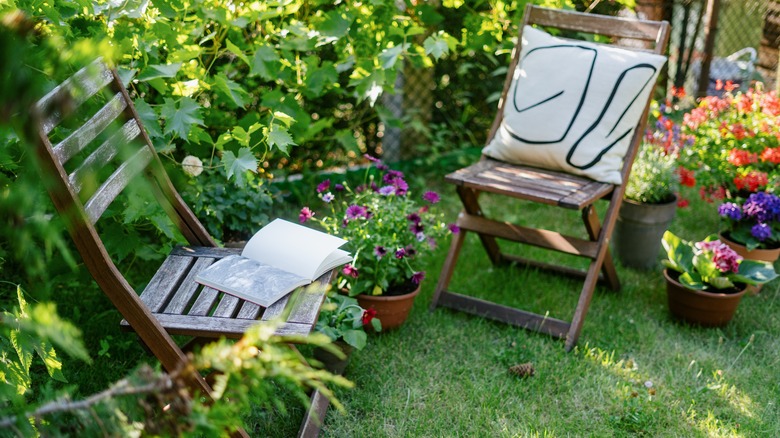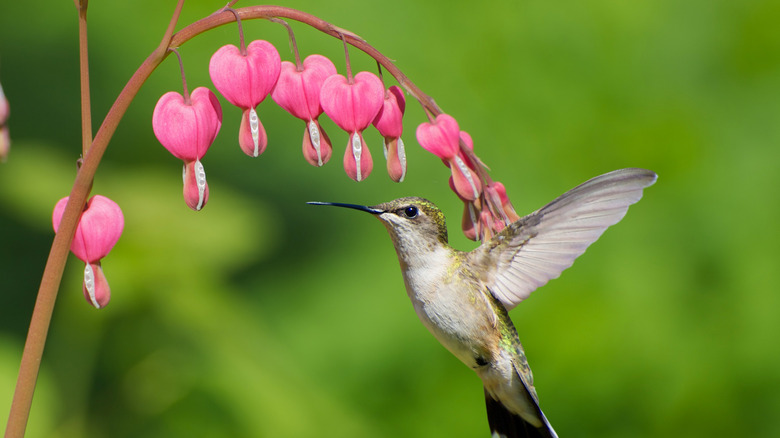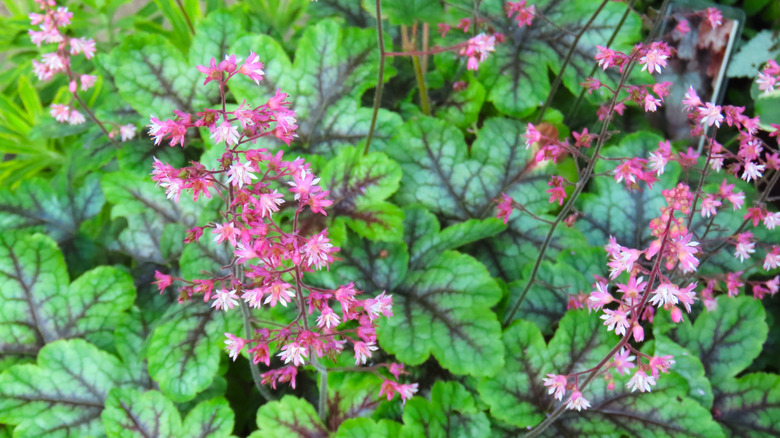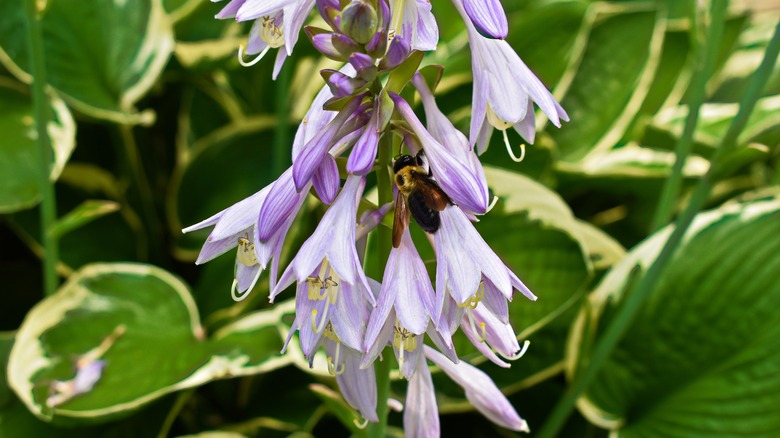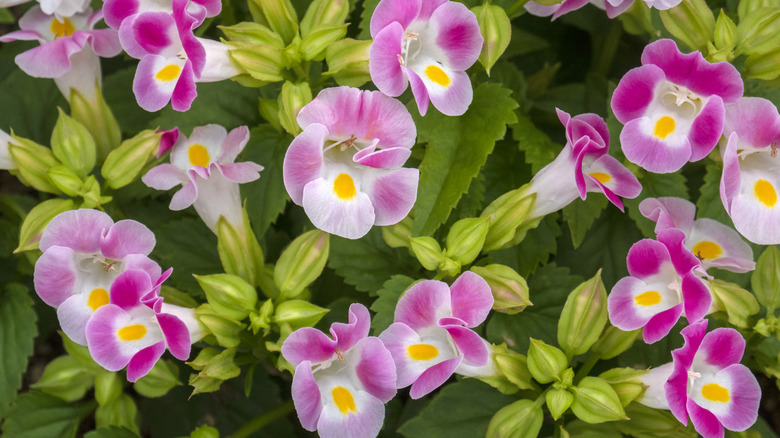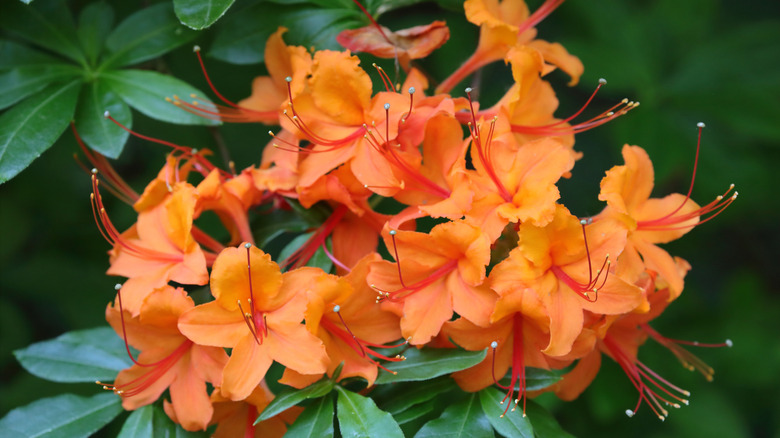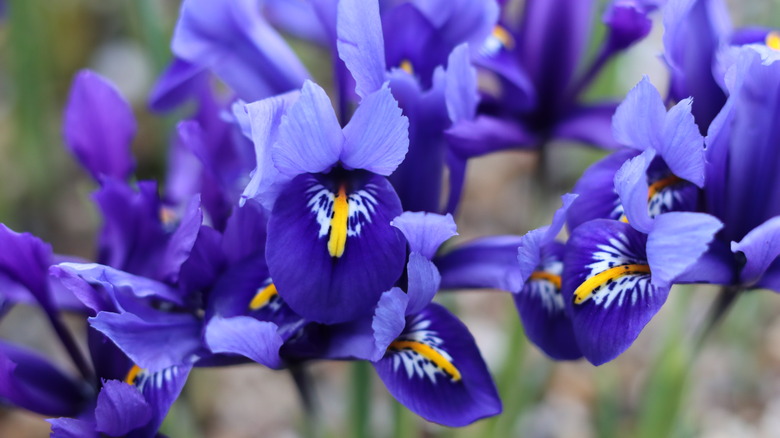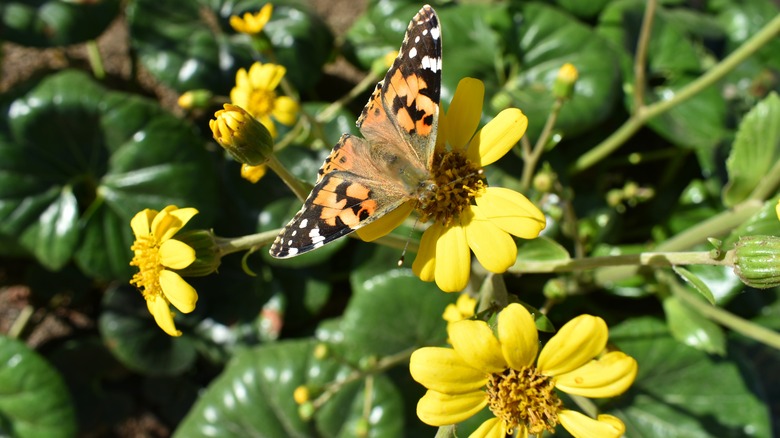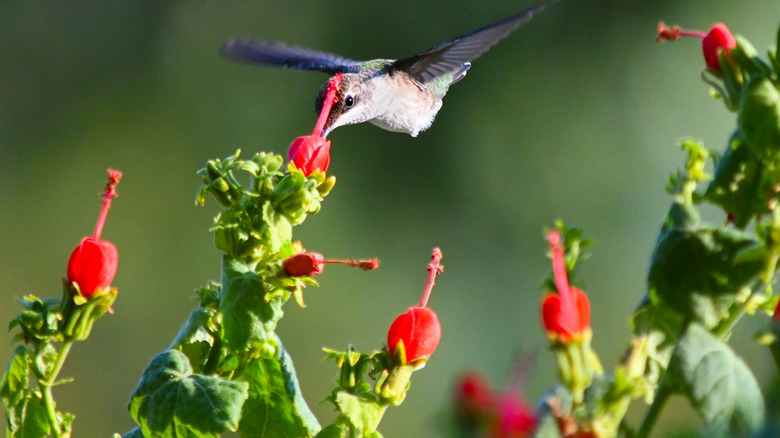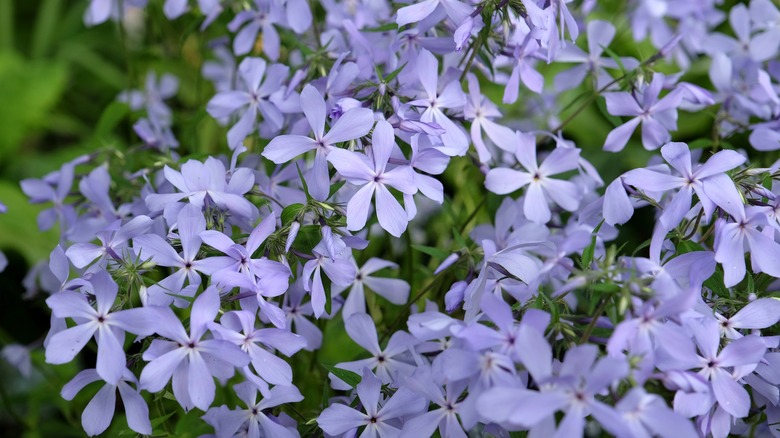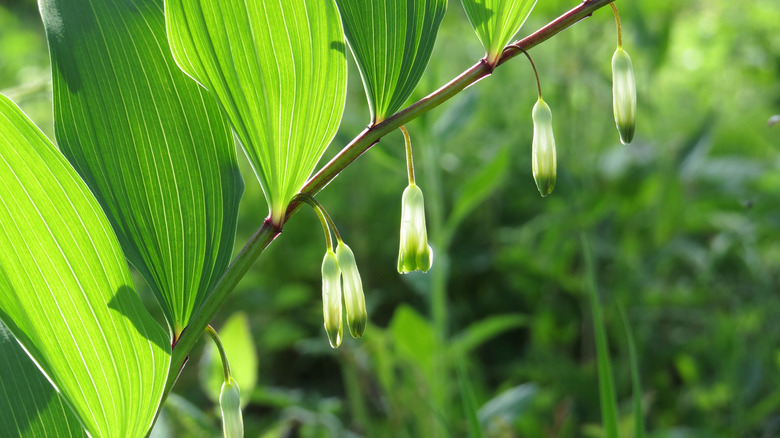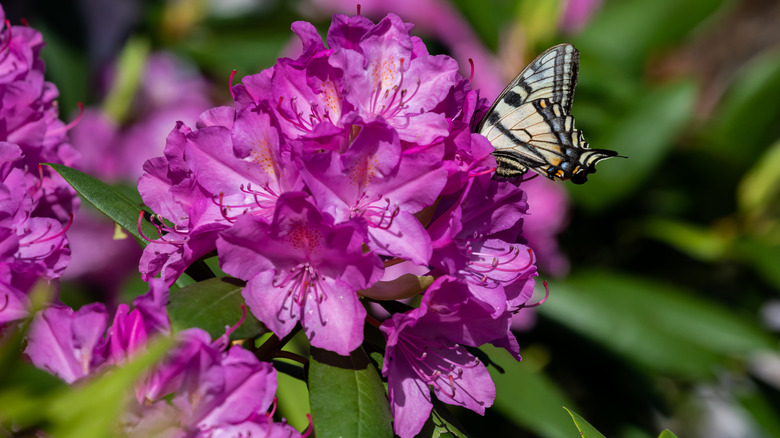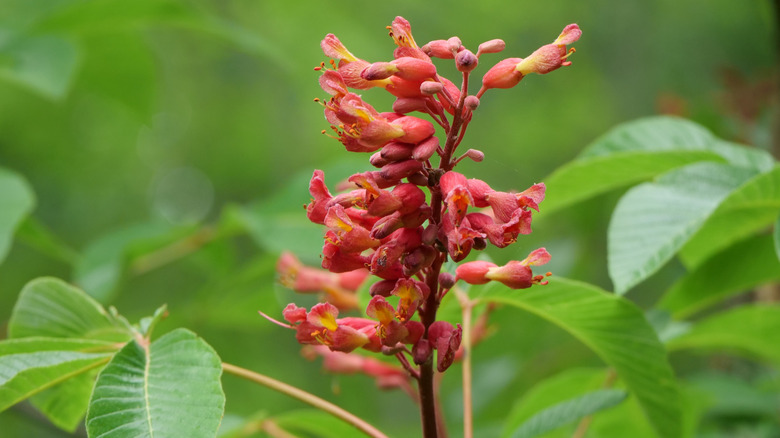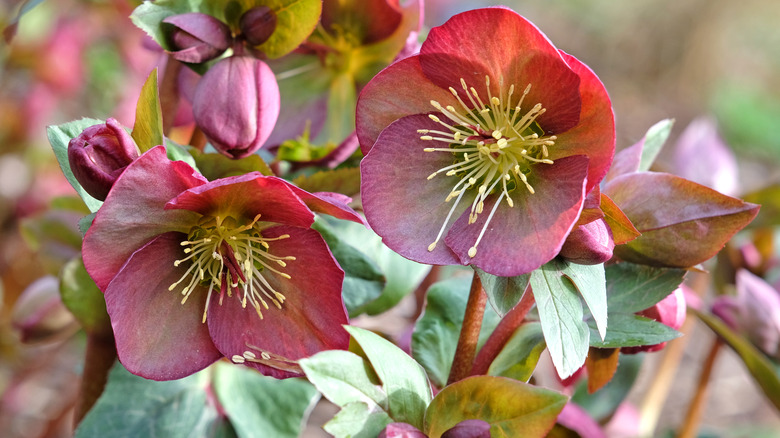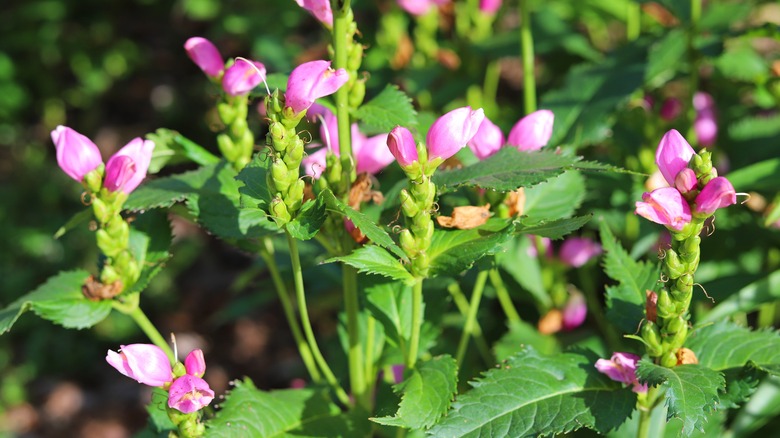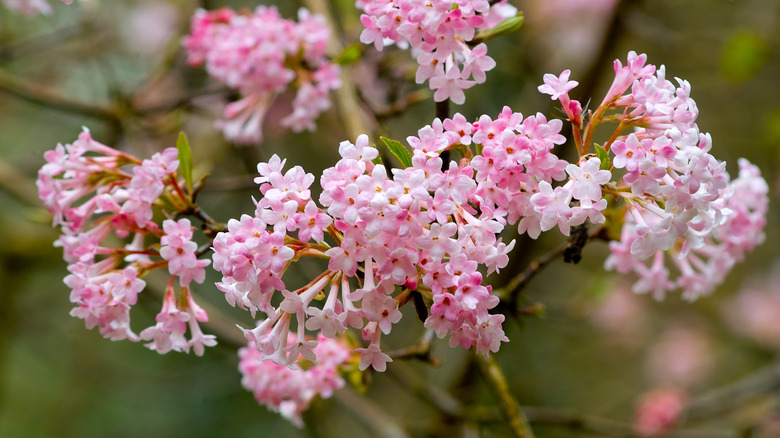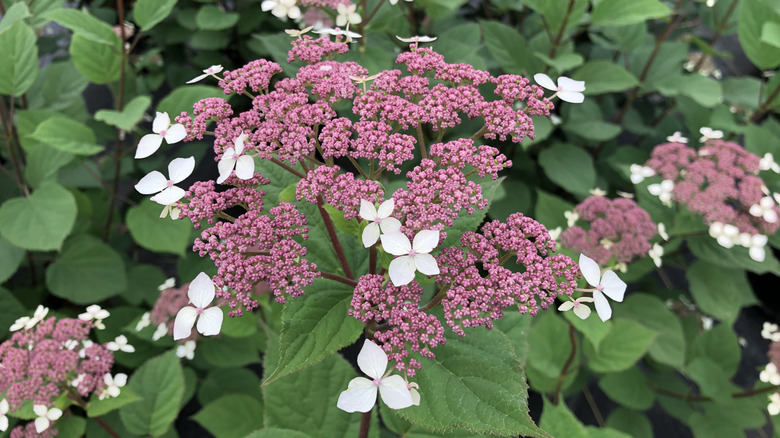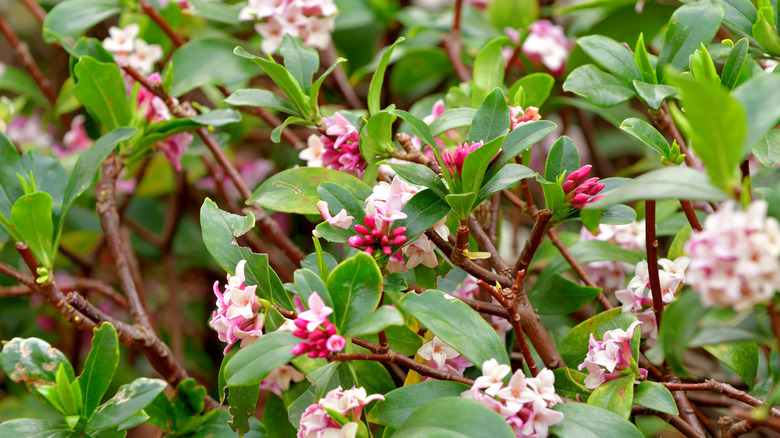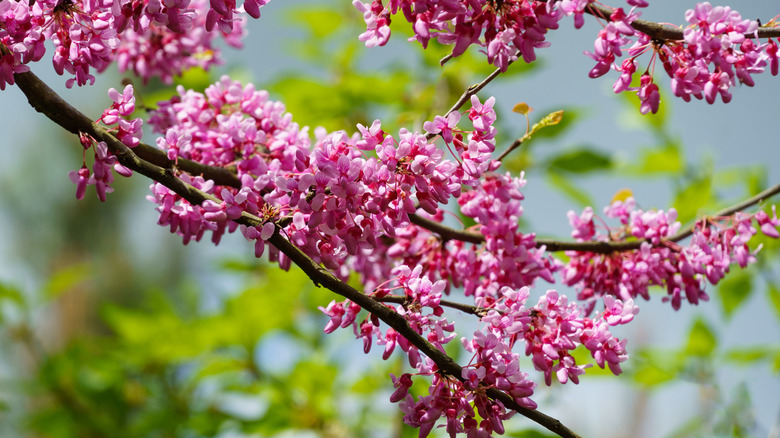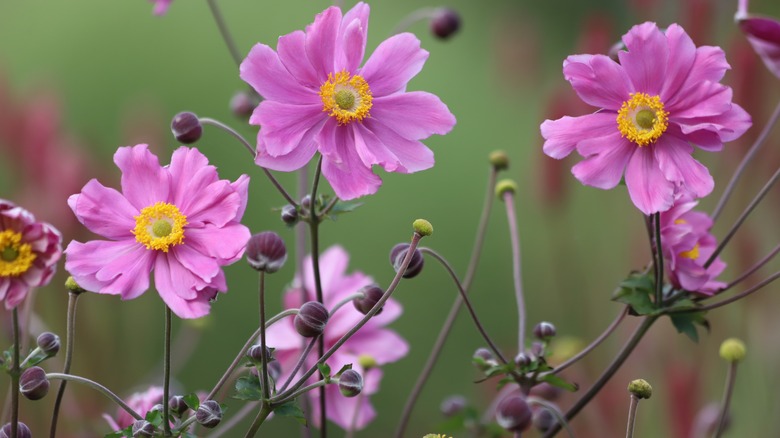21 Shade Plants That Attract Hummingbirds And Pollinators To Your Yard
Just because parts of your yard don't receive a lot of light doesn't mean you can't grow a flourishing shade garden that's buzzing with your favorite pollinators. By filling the shaded areas with their favorite plants, you'll give insects and birds a nice, cool place to drink nectar, build habitats, or escape the heat when the sun gets a little too intense. Whether you're looking for flowers, shrubs, or trees, there's a pollinator-friendly plant that will thrive in those shadier corners.
To attract more hummingbirds, butterflies, bees, and other pollinators using shade plants, choose a few varieties that bloom at different times throughout the year so food's always readily available. Additionally, mix and match shapes and colors to get the widest variety of garden visitors. Hummingbirds can easily spot warm hues, especially red, though they'll stop by other colors as well. Opt for tubular flowers if you want to see these small birds, as they accommodate their long bills and tongues better than other shapes. Butterflies are attracted to bright colors like pink, red, orange, yellow, and purple. Bees can't see the color red and are most drawn to purple and blue shades. If you're not sure where to start, use the list below to discover the best shade plants that hummingbirds and other pollinators can't get enough of.
Old-fashioned bleeding heart
In a shady garden, few plants perform better at attracting hummingbirds than the classic old-fashioned bleeding heart (Lamprocapnos spectabilis). Although it can tolerate nearly any light conditions, it thrives when it gets morning sun followed by shade during the hottest part of the day. The pink, heart-shaped blooms dangling from its arching stems are irresistible to hummingbirds and butterflies, making it perfect for the shady edges of a pollinator garden. You can grow this herbaceous perennial in USDA Hardiness Zones 3 through 9. Plant in beds, borders, or containers in well-drained, neutral to alkaline, humusy soil.
Foamy bells
Coral bells (Heuchera spp.) have been a garden staple for ages, but there may be an alternative you've never heard of. If you want to attract pollinators to your shade garden, don't overlook foamy bells (x Heucherella), a stunning hybrid that pairs Heuchera's showy foliage with Tiarella's profuse blooms. In spring to mid-summer, tall stems emerge with a profusion of small creamy white or pink flowers that are like magnets to hummingbirds and butterflies. Like its parent plants, foamy bells thrive in shady conditions, including deep shade. It's hardy in zones 4 through 11 and likes rich, well-drained soil.
Toad lily
Featuring orchid-like blooms freckled with purple spots that mimic a toad's skin, the toad lily (Tricyrtis formosana) is a late-summer beauty that hummingbirds can't get enough of. These beautiful flowers grow perfectly in shade, though they perform better in light shade than in fully shaded areas. They thrive in hardiness zones 4 through 9 and look stunning whether growing in a patio container, along a pond's edge or lined up in a shady border. Plant this unique flower in humus-rich, well-drained, slightly acidic soils and water regularly.
Hostas
Hostas may be the go-to foliage plant, but you can't forget about their purplish, tubular blooms that emerge in mid to late summer. Hummingbirds, bees, and butterflies will line up to drink the nectar, livening up the shady patches of your garden. Choose a blue-leaved variety if you want to grow your hostas in deeply shaded areas, and go for green-leaved types if you want to add color to a partially shaded area. There are a variety of cultivars to choose from, and you can plant them anywhere in zones 3 through 9.
Wishbone flower
If you want to plant the perfect hanging basket in a shady area, you can't go wrong with a wishbone flower (Torenia fournieri). Each bloom is shaped like an individual snapdragon but is two-toned and painted with a bright yellow marking. There are bushy and trailing varieties to choose from in an array of cultivars that come in pinks, purples, and yellows. They'll happily grow in part sun to full shade and are perfect for attracting hummingbirds and other pollinators. Grow them as an annual in zones 2 through 11 in rich, well-drained soil.
Flame azalea
Flame azaleas (Rhododendron calendulaceum) are gorgeous flowering shrubs that thrive in shade in zones 5 through 7. This species is made for native pollinator gardens, as its clusters of vibrant red, pink, orange, or yellow, funnel-shaped blooms are a big hit among hummingbirds, butterflies, and bees. Despite its warm, exotic appearance, it can grow in full sun to full shade, though it's happiest when it gets a few hours of sun each day. Plant this azalea in line with a window so you don't miss out on the pollinator show in late spring to early summer.
Cardinal flower
With spiked clusters of bright red, tubular blooms, cardinal flower (Lobelia cardinalis) is one of the best native plants for a sustainable approach to attracting hummingbirds. Naturally growing in marshes, swamps, and streambanks, you can easily tuck it in a shady area of a rain garden. Hardy in zones 3 through 9, this wildflower thrives when it gets dappled sun or shade during hot afternoons, especially in warmer regions. Cardinal flower can handle nearly any soil you stick it in as long as it stays moist. Beware, it's toxic if ingested.
Crested iris
Crested iris (Iris cristata) is another fabulous native that will encourage multiple visits from hummingbirds and butterflies. It blooms in early to late spring, featuring blue, purple, or white iris-shaped flowers that are surrounded by its attractive sword-shaped green leaves. Growing only 4 to 9 inches tall, this spreading variety makes a colorful ground cover plant that loves shade. This early spring perennial is perfect for gardens in zones 3 through 9 and thrives in partial shade. Although it likes well-drained, rich, acidic soil, an overabundance of nutrients will encourage more foliage growth at the expense of its blooms.
Leopard plant
Leopard plant (Farfugium japonicum) is an underrated herbaceous perennial for zones 7 through 9. It offers showy, glossy green, rounded leaves with yellow spots and clusters of sunny, daisy-like blooms that appear in fall or winter and attract bees, butterflies, and other pollinators. While hummingbirds aren't regular pollinators, they collect fine plant down for nesting, so those fuzzy seedheads might get snipped for nest lining. Unlike daisies, these yellow flowers are better suited for shaded areas, as their foliage can wilt and burn with too much sun. Leopard plant can tolerate a range of soil but prefers moist, rich soils.
Turk's cap
Turk's cap (Malvaviscus arboreus var. drummondii) is the perfect choice to liven up a shady garden with an array of wildlife. It features cherry red, hibiscus-like flowers that provide plenty of fresh nectar for hummingbirds and butterflies from spring through fall. Once the long blooming season comes to an end, fruits emerge to give birds a source of nutrition during the cooler months. This spreading shrub can tolerate a range of conditions but prefers part shade and well-drained soil. It's hardy in zones 7 through 10 and freezes to the ground in cold climates.
Woodland phlox
If you're in hardiness zones 3 through 8, make sure to plant woodland phlox (Phlox divaricata) in your garden to get an explosion of early to mid-spring, slightly fragrant, pastel blooms. They're incredibly showy, signaling to pollinators that there are plenty of flowers to go around. Butterflies, bees, and hummingbirds all enjoy their small, tubular, bluish to lavender flowers. This native wildflower thrives in partial to full shade, making it a great understory for taller perennials or use as a soft groundcover. Choose an organically rich, well-drained soil blend and keep the soil regularly moist.
Fragrant Solomon's seal
It can be tricky to find the perfect plants to add more texture and color underneath trees, but fragrant Solomon's seal (Polygonatum odoratum var. pluriflorum 'Variegatum') is made for such shady locations. Its gracefully arching stems with white, bell-shaped flowers dangling beneath beautifully decorate a woodland's edge and come with attractive green-and-cream variegated leaves that look beautiful through fall. Those little bells are highly sought after by pollinators, so your yard will be buzzing with early-season bees, butterflies, and hummingbirds. This shade-loving understory plant is hardy in zones 3 through 8 and likes humusy, well-drained soil.
Rhododendron
Rhododendron (Rhododendron spp.) is a flowering shrub that's sure to attract hummingbirds, butterflies, and even specialized bees. You can find a cultivar in nearly any color you like, including blue, with each shrub putting out a showy display of clustered, funnel-shaped blooms that add bright color to your garden for weeks in spring. These popular shade plants thrive in dappled sun or afternoon shade, where they receive enough light to bloom but not so much so that the leaves burn. Hardy in zones 4 through 8, rhododendrons cannot tolerate poor drainage and thrive in acidic, organically rich soil.
Red buckeye
Also called firecracker plant, red buckeye (Aesculus pavia) is a gorgeous shrub with pretty red flowers that's a must for hummingbird lovers. In spring, clusters of small, tube-shaped blooms emerge in panicles at the ends of branches, creating a dazzling burst of red that the tiny hummers can't resist. This shade-tolerant beauty thrives in partial shade, as too much sun can scorch the leaves. You can grow red buckeye in zones 4 through 8 in moist, well-drained soil.
Lenten rose
Sometimes nicknamed winter rose because of their extremely early-season blooms, lenten roses (Helleborus spp.) are the perfect way to add some color when other plants are still waking up. Their rose-like, cup-shaped blooms brighten your garden in late winter to early spring, giving pollinators like bees and hummingbirds early nectar when flowering plants are scarce. Even when not in bloom, its attractive evergreen foliage adds a touch of greenery in zones 5 through 8. This clumping perennial performs best in partial shade or filtered sunlight and rich, well-drained soils with neutral to alkaline pH.
Red turtlehead
Aptly named, the Chelone genus gets its common name from the bloom's distinctive turtle-head shape. There are several turtlehead varieties to choose from, though the rosy petals of red turtlehead (Chelone obliqua var. obliqua) are most likely to catch the eye of hummingbirds in mid-summer to fall. It's another shade-loving native perennial you can plant in a pollinator garden as long as you're in zones 5 through 9. Plant this variety in rich, humusy soil and water regularly. With its tolerance of wet sites, it's also perfect for a rain garden.
Viburnum 'Dawn'
Bodnant Viburnum 'Dawn' (Viburnum × bodnantense 'Dawn') is a shrub that can do it all. It's extremely fragrant, so your backyard will have that delicious smell of fresh blooms in the air in early spring. The clusters of small, tubular, rosy pink flowers cover the branches, enticing hummingbirds and butterflies to take a drink. The drupes that follow attract songbirds, while the branches make a perfect spot for birds to perch. This showy cultivar is easily grown in zones 5 through 8, where it likes partial sun and moist, well-drained soil.
'Invincibelle Lace' hydrangea
While most hydrangeas are pollinator magnets, you'll want to consider the cultivar 'Invincibelle Lace' (Hydrangea arborescens subsp. radiata) if you want more hummingbirds, bees, and butterflies in your yard. Lacecap varieties are more nectar-rich, making them the best for attracting pollinators. So, it's no surprise that the large, purplish lacecap flowers make this shrub a hot spot for our favorite garden visitors. This variety is hardy in zones 3 through 8 and thrives when given shade during hot afternoons. It'll grow well in any soil with good drainage.
Fragrant daphne
Fragrant daphne (Daphne odora) is another winter-blooming plant that will have hummingbirds visiting your yard year-round, with its pinkish or purple flowers coming to life in late winter to early spring. Hummingbirds, bees, and butterflies will flock to its sweet-scented cymes, while the dense branches provide plenty of nesting spots for birds. Its evergreen foliage is attractive throughout every season in zones 7 through 9. Soil with excellent drainage is a must, and it's best to let it dry out between waterings.
Eastern redbud
For a yard buzzing with wildlife, you won't want to skip the eastern redbud (Cercis canadensis) if you're in zones 4 through 9. This shade-loving native is incredibly ornamental, with its show of bright red flowers that emerge in spring. Hummingbirds and other pollinators will drink nectar from its profuse blooms, and over a dozen insects rely on this tree as a host plant. In summer or fall, songbirds will stop by to snack on the seeds. Choose a shady site for your redbud, and plant it in moist, well-drained soil.
Japanese anemone
If you want to encourage hummingbirds to nest in your yard, make sure to add plants like Japanese anemone (Anemone x hybrida). In mid-summer to fall, the cup-shaped flowers provide plenty of nectar for bees, hummingbirds, and butterflies before the petals drop to reveal the seed heads. Once they dry, they become a fluffy, cotton-ball-like material hummingbirds use to line their nests. Use this low-maintenance perennial for gardens in zones 4 through 8. They prefer partial shade, especially in the south, along with consistently moist, fertile, well-drained soils.
